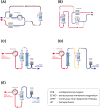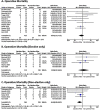The role of hemoadsorption in cardiac surgery - a systematic review
- PMID: 38762715
- PMCID: PMC11102180
- DOI: 10.1186/s12872-024-03938-4
The role of hemoadsorption in cardiac surgery - a systematic review
Abstract
Background: Extracorporeal blood purification has been widely used in intensive care medicine, nephrology, toxicology, and other fields. During the last decade, with the emergence of new adsorptive blood purification devices, hemoadsorption has been increasingly applied during CPB in cardiac surgery, for patients at different inflammatory risks, or for postoperative complications. Clinical evidence so far has not provided definite answers concerning this adjunctive treatment. The current systematic review aimed to critically assess the role of perioperative hemoadsorption in cardiac surgery, by summarizing the current knowledge in this clinical setting.
Methods: A literature search of PubMed, Cochrane library, and the database provided by CytoSorbents was conducted on June 1st, 2023. The search terms were chosen by applying neutral search keywords to perform a non-biased systematic search, including language variations of terms "cardiac surgery" and "hemoadsorption". The screening and selection process followed scientific principles (PRISMA statement). Abstracts were considered for inclusion if they were written in English and published within the last ten years. Publications were eligible for assessment if reporting on original data from any type of study (excluding case reports) in which a hemoadsorption device was investigated during or after cardiac surgery. Results were summarized according to sub-fields and presented in a tabular view.
Results: The search resulted in 29 publications with a total of 1,057 patients who were treated with hemoadsorption and 988 control patients. Articles were grouped and descriptively analyzed due to the remarkable variability in study designs, however, all reported exclusively on CytoSorb® therapy. A total of 62% (18/29) of the included articles reported on safety and no unanticipated adverse events have been observed. The most frequently reported clinical outcome associated with hemoadsorption was reduced vasopressor demand resulting in better hemodynamic stability.
Conclusions: The role of hemoadsorption in cardiac surgery seems to be justified in selected high-risk cases in infective endocarditis, aortic surgery, heart transplantation, and emergency surgery in patients under antithrombotic therapy, as well as in those who develop a dysregulated inflammatory response, vasoplegia, or septic shock postoperatively. Future large randomized controlled trials are needed to better define proper patient selection, dosing, and timing of the therapy.
Keywords: Aortic surgery; Blood purification; Cardiac surgery; CytoSorb; ECMO; Heart transplantation; Hemoadsorption; Hyperinflammation; Infective endocarditis.
© 2024. The Author(s).
Conflict of interest statement
MMS, DW, and ED are employees of CytoSorbents corp.
Figures






References
Publication types
MeSH terms
LinkOut - more resources
Full Text Sources
Medical

